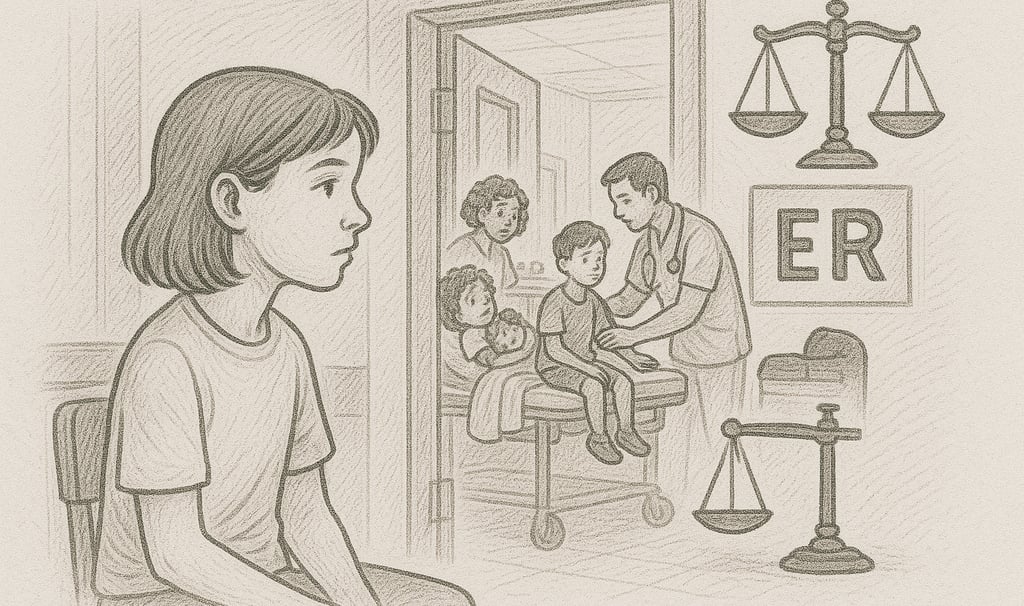The ER Was My Classroom: How Watching Broken Children Shaped My Fight for Justice
Bevin Carter
5/18/20255 min read


Introduction to My Story
Growing up, my environment was far from ordinary; it was a domain riddled with challenges that shaped my perspective on life. As a child, I often found myself in emergency rooms, witnessing the raw reality of suffering and the resilience of broken children. Those experiences spurred deep reflections on the nature of pain, suffering, and the systemic injustices that often exacerbate these issues. It was within the confines of the emergency room that I formed an awareness that would become the cornerstone of my lifelong dedication to advocacy.
Observing children in distress in the ER allowed me to confront the harsh realities of life from a very young age. I watched as young patients endured unimaginable pain, often with little voice or recourse. This visceral exposure sparked my curiosity about the factors that contribute to such inequality in healthcare and the broader societal structures that perpetuate injustice. Each story I encountered in those sterile, fluorescent-lit hallways became a profound iteration of a larger narrative about vulnerability and the need for systemic change.
The emergency rooms became, in essence, my classroom. Each visit provided invaluable lessons about empathy, compassion, and the strength found in human resilience. I learned that while healthcare professionals are essential in mitigating physical ailments, they often grapple with the limitations imposed by socioeconomic factors. This realization prompted a desire within me to become not just an observer, but an advocate for those who cannot advocate for themselves. Thus, it became evident that my journey would be intertwined with the quest for justice, driven by a deep personal connection to the suffering I witnessed. These formative experiences laid the groundwork for my fight against the injustices that plague the systems designed to protect our most vulnerable populations.
Lessons Learned in the Emergency Room
My time in the emergency room was punctuated by encounters that revealed the stark realities faced by vulnerable children. Each visit brought me into contact with young patients whose lives were fraught with challenges that few adults could ever comprehend. One particular incident that stands out is the case of a six-year-old boy who arrived with multiple bruises and a fractured arm. Through gentle whispers, he recounted a story marked not just by physical pain but by emotional scars; the trust he had lost due to a fractured family environment resonated with me deeply. This experience taught me about compassion, understanding, and the importance of providing support to those who feel alone in their suffering.
Another encounter involved a ten-year-old girl who had been brought in with symptoms of severe anxiety, a condition exacerbated by an unstable home life. Despite her predicament, she exhibited an incredible resilience, often smiling through her discomfort. Her will to overcome challenges served as a poignant reminder that children possess an innate strength that can emerge even in the harshest conditions. Observing her showed me that even in moments of adversity, there exists a flicker of hope that can spark change.
These experiences underscored the systemic failures that often perpetuate such adversities, revealing a pressing need for reform in how we support affected families. Encountering these young patients in their moments of need illuminated the disparities present within our healthcare system, emphasizing the essential requirement for empathy and advocacy. Such profound lessons in the ER were not merely fleeting moments; they became critical educational experiences, shaping my views on justice and the urgent need to address social inequities. The resilience of these broken children inspired me to dedicate myself to a pursuit of justice, seeking to alter the circumstances that lead to such suffering.
Transforming Pain into Purpose
My early encounters in the emergency room, where I witnessed the struggles of broken children, served as a profound catalyst for transformation in my life. The pain and confusion I initially felt were later channeled into a purposeful mission that would shape my aspirations and career in advocacy and social justice. Observing the vulnerabilities of these children exposed the systemic gaps within our society and ignited a determination in me to take action. This journey was not merely a professional path but rather a personal calling driven by empathy and the desire to effect meaningful change.
As I processed the heart-wrenching realities faced by these children, I began to understand the importance of advocacy. I realized that by remaining a passive observer, I was complicit in the injustices surrounding them. This realization triggered my transition from feeling helpless to feeling empowered—a transformation that would fuel my educational pursuits. I enrolled in courses focused on social work and public policy, comprehensively understanding the factors contributing to the struggles of at-risk children. Each lesson served not only as an academic exercise but also as a confirmation of my commitment to fighting injustice.
Beyond the classroom, my involvement in various community initiatives and organizations solidified my focus on social advocacy. Volunteering in shelters and participating in awareness campaigns allowed me to engage directly with those in need, transforming my initial observations into informed action. The education I received, paired with firsthand experiences, equipped me with the tools necessary to advocate for equitable policies. My mission has evolved beyond personal pain to encompass the collective welfare of marginalized children, transforming my life into a vanguard for justice and change.
Advocacy for Vulnerable Populations
As we reflect on the experiences that highlight the struggles faced by vulnerable populations, particularly children, it becomes essential to take actionable steps toward advocacy. Children are among the most affected by systemic injustices, and by recognizing their plight, we can contribute to meaningful change in our communities. Advocacy for these kids is not just a duty but a moral imperative that calls upon us to engage and educate ourselves about the challenges they face.
To initiate this change, it is crucial to understand the broader implications of these systemic injustices. Issues like poverty, access to healthcare, and educational inequities disproportionately affect vulnerable populations, leaving them without necessary support. By acknowledging these factors, we are better equipped to challenge the status quo and work toward solutions that promote equity and justice for all. Everyone has a role to play, and each small action can ripple outward, fostering a community better prepared to uplift its most vulnerable members.
There are several practical steps individuals can take to contribute to advocacy efforts. Firstly, educating oneself and others about the experiences of vulnerable children is vital; reading articles, attending community meetings, or volunteering with local organizations can build awareness. Additionally, becoming involved in policy discussions can influence systemic change. Advocating for improved resources, funding, and legislative support ensures that children's rights are prioritized at local and national levels.
Furthermore, consider supporting organizations dedicated to safeguarding children's welfare. Donations, volunteering time, or simply raising awareness about these organizations can significantly impact their ability to serve. By working collectively, we can create avenues for healing and support that are essential for vulnerable populations. In conclusion, our advocacy efforts can unlock doors to opportunity, demonstrating that every voice counts in the fight for justice.
Let us stand together for those who need it the most.
